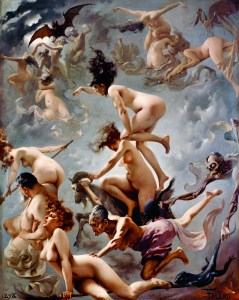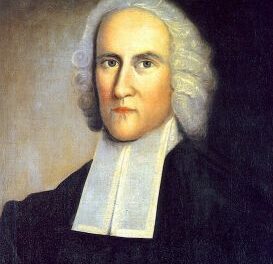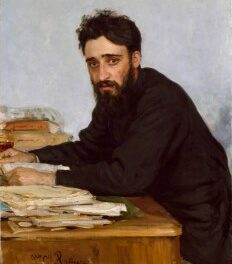We support our Publishers and Content Creators. You can view this story on their website by CLICKING HERE.
As another Halloween approaches, the memory leads me to ponder this annual festival of all that is ghoulish and ghostly. Is it all harmless fun or, in our increasingly secular age, are we in danger of dabbling with dark forces beyond our understanding?
 In the early 1980s when I was a young Anglican priest I served in a parish on the South Coast of England where a man named Alex Sanders had set up a coven of witches. In the 1960s Alex had won notoriety in the British press as “The King of the Witches” and he claimed to be the successor of the notorious occultist Aleister Crowley.
In the early 1980s when I was a young Anglican priest I served in a parish on the South Coast of England where a man named Alex Sanders had set up a coven of witches. In the 1960s Alex had won notoriety in the British press as “The King of the Witches” and he claimed to be the successor of the notorious occultist Aleister Crowley.
I never met Sanders, but stories circulated in the town about his mesmerizing hold on young women, his promiscuous lifestyle, and intense involvement in witchcraft. The only exorcism I have witnessed took place during those years. It was of a fifteen-year-old schoolgirl who had been “hanging out with Alex” at a local pub. It was a frightening encounter I never wish to experience again, and it was enough to make me worry about witches and take the threat of their existence seriously. It was also enough to remind me that not only that witches are real, but also that their works of darkness include sexual promiscuity and the initiation of children through sexual abuse.
As another Halloween approaches, the memory leads me to ponder this annual festival of all that is ghoulish and ghostly. Is it all harmless fun or, in our increasingly secular age, are we in danger of dabbling with dark forces beyond our understanding? What about books, movies, and TV shows that normalize or even glamorize witchcraft and magic? Are they mere entertainment or dangerous portals to the dark side? If they are dangerous, how much worse that these enchantments are the playground for children?
We need to balance concern with common sense. All these practices and interests (and many more) can indeed open the door to the devil. If a human soul is without faith and has no real religion, it is vulnerable and most any interest can become a fascination, then an obsession, and then lead to oppression and possession by malignant entities.
On the other hand, a person who is baptized, believing and practicing his Christian faith is protected from the enemy. This doesn’t mean that he may dabble in the dark arts with impunity. It should mean that he is free at the start from a fascination with the dark side.
Must one avoid Harry Potter stories with their context of witches and wizards? While we should take the threat of the occult seriously, in my opinion there is no need to be overly worried about witches in fairy tales. Magicians, witches, and wizards have been the stock in trade of fantasy stories from the beginning, and the existence of witches in fiction is of secondary importance to how the witchcraft is treated. If the story is a battle between good and evil and the wicked witch is defeated, then the story has a proper function. The lesson is taught that the dragon is slain, and although the wicked witch exists, she is overcome. So the mere existence of witches and wizards in a story should not be too much of a concern.
However, should a child become so entranced by Harry Potter that he or she gets a book of spells and starts to dabble in witchcraft itself, then the books can indeed be the doorway to the dark. The same can be said of an obsession with certain types of horror films, demonic rock music, gruesome video games, and occult role-play games.
It is difficult to imagine what the world was like before the coming of Christ, but a film like Mel Gibson’s Apocalypto, which portrays the horrific barbarity of the late Aztec age, is an indication. The pagan religions consisted of ritual offerings to bloodthirsty deities. The temples were labyrinthine chambers with possessed soothsayers and mediums invoking the dead: appeasing their gods, offering sacrifices, casting spells, muttering incantations and curses. They were chambers of horrors—corridors of the occult and the haven of covens. The priests and priestesses of the dark religions worshipped demons and were the stewards of the mysteries of the underworld.
In the midst of this shadowy world of witchcraft the new Christian faith burst forth like the fresh light of a Spring morning. In the midst of the darkness St Paul encouraged the Christians: “For you were once darkness, but now you are light in the Lord. Live as children of light (for the fruit of the light consists in all goodness, righteousness and truth) and find out what pleases the Lord. Have nothing to do with the fruitless deeds of darkness, but rather expose them. It is shameful even to mention what the disobedient do in secret. But everything exposed by the light becomes visible—and everything that is illuminated becomes a light” (Ephesians 5:8-13).
This release of light is the answer to the worry about witches today. Christians acknowledge the dark, but live in the light, and the pure witness of that light should banish the emptiness of the dark.
During the same time of my early work as a young priest, I attended a weekend seminar by a well-known exorcist and psychiatrist. He was a softly spoken but intense Englishman who was very experienced in dealing with those imprisoned by dark forces. In the audience were several women from a local town, and during the question-and-answer period they asked, somewhat breathlessly, “We have a coven of witches in our town. What should we do to pray against them?” They obviously expected a sensational answer—advising them how to counter the evil presence.
The good doctor said, “You know, in my experience, nine times out of ten when there is some kind of spiritual darkness all that is required is for two or three Christians to gather together and pray the Lord’s prayer with an emphasis on ‘deliver us from evil.’”
If this is so, then we should take witches seriously, but not too seriously. After all, they are backing not only the losing side, but the side that has already been defeated.
The Imaginative Conservative applies the principle of appreciation to the discussion of culture and politics—we approach dialogue with magnanimity rather than with mere civility. Will you help us remain a refreshing oasis in the increasingly contentious arena of modern discourse? Please consider donating now.
The featured image is “Witches going to their Sabbath” (1878) by Luis Ricardo Falero, and in the public domain, courtesy of Wikimedia Commons.
Share This Story, Choose Your Platform!
Go to Top

 Conservative
Conservative  Search
Search Trending
Trending Current News
Current News 






